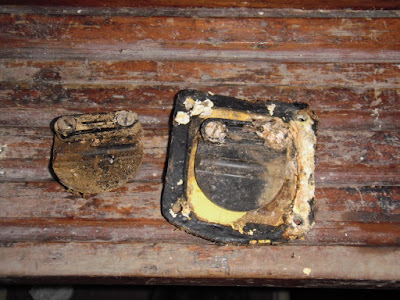Saloon bilge pump
The keen eyed amongst you will of course have noticed that a couple more hose clips are required to complete the bilge pump installation.
When I installed the discharge hose for the engine space bilge pump I assumed that as the skin fitting was on the starboard side the hose would be a straight run from the starboard side hose connection on the bilge pump but on stripping the pump this turned out to be a wrong assumption. This pump is hung from the underside of the cockpit floor and to end up with the pump discharge on the starboard side it was only a matter of removing two bolts and inverting the pump however the two bolts were proving to be obstinate and with there not being a lot of room I decided to remove the whole pump.
Engine space bilge pump
The mounting bolt holes turned out to have nylon bushes with the bolts being a tight fit in fact I had to drive them out.
Nylon bushes moved to new position to allow inversion of the pump body
Old pump valves from engine space pump
Old pump diaphragms
The old valves were removed and the parts cleaned up ready for reassembly with new valves the suction and discharge valves bot utilise the same rubber flap except that the discharge valve is fitted to a frame and inverted. The service kit includes new screws for securing the valves the four short screws are for securing the flap valves and the four longer screws are for securing the discharge valve frame.
New suction valve fitted discharge valve on the left
The above photograph shows the pump after being inverted to bring the discharge hose connection to the starboard side and both new valves fitted it just needs the new diaphragm fitting and then replacing in position which will be the first job on Monday.
In between working on the two pumps I resealed a couple of the leaking toe rail bolts using penny washers and some closed cell neoprene tape just need another rainy day know to test the repairs.





















































